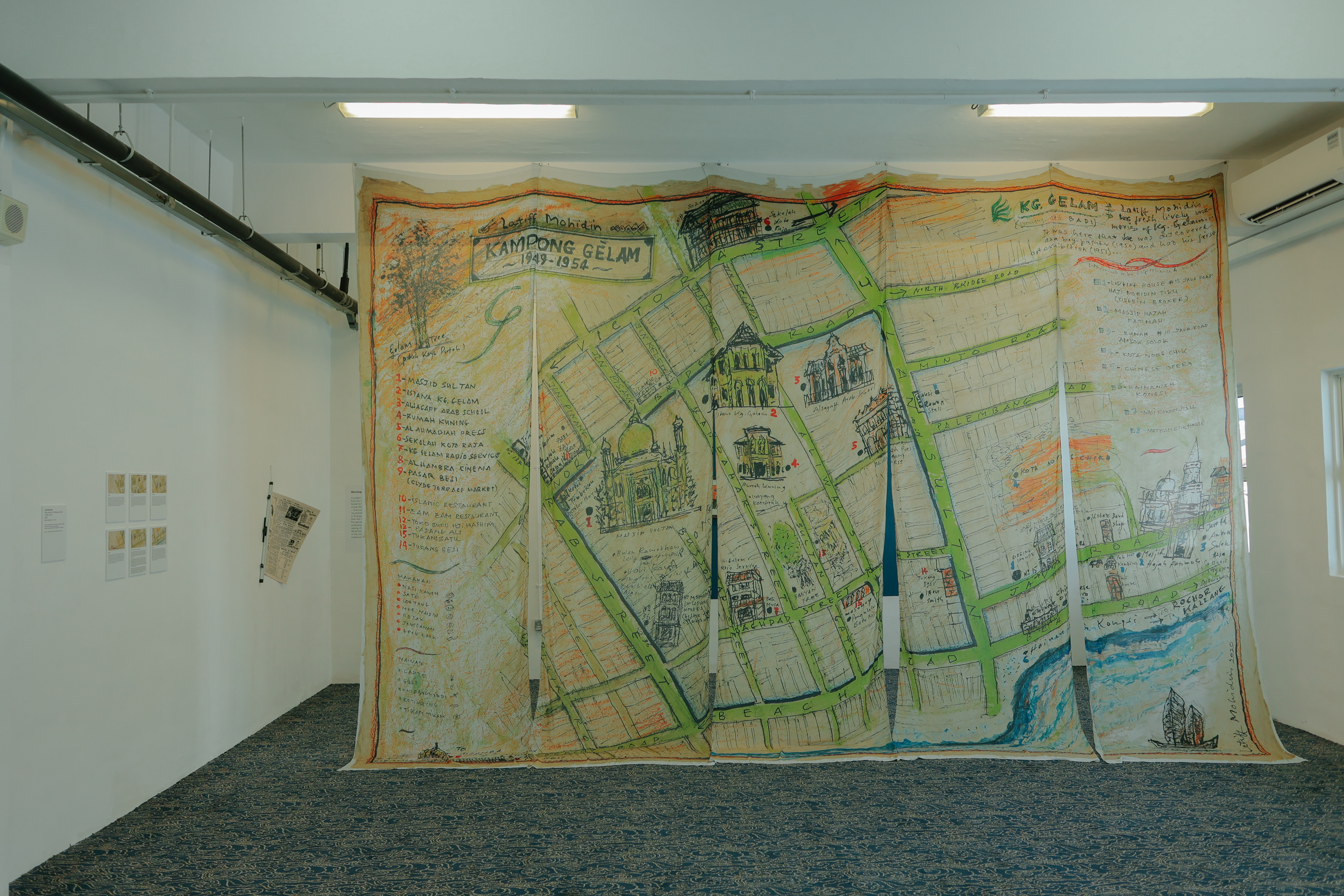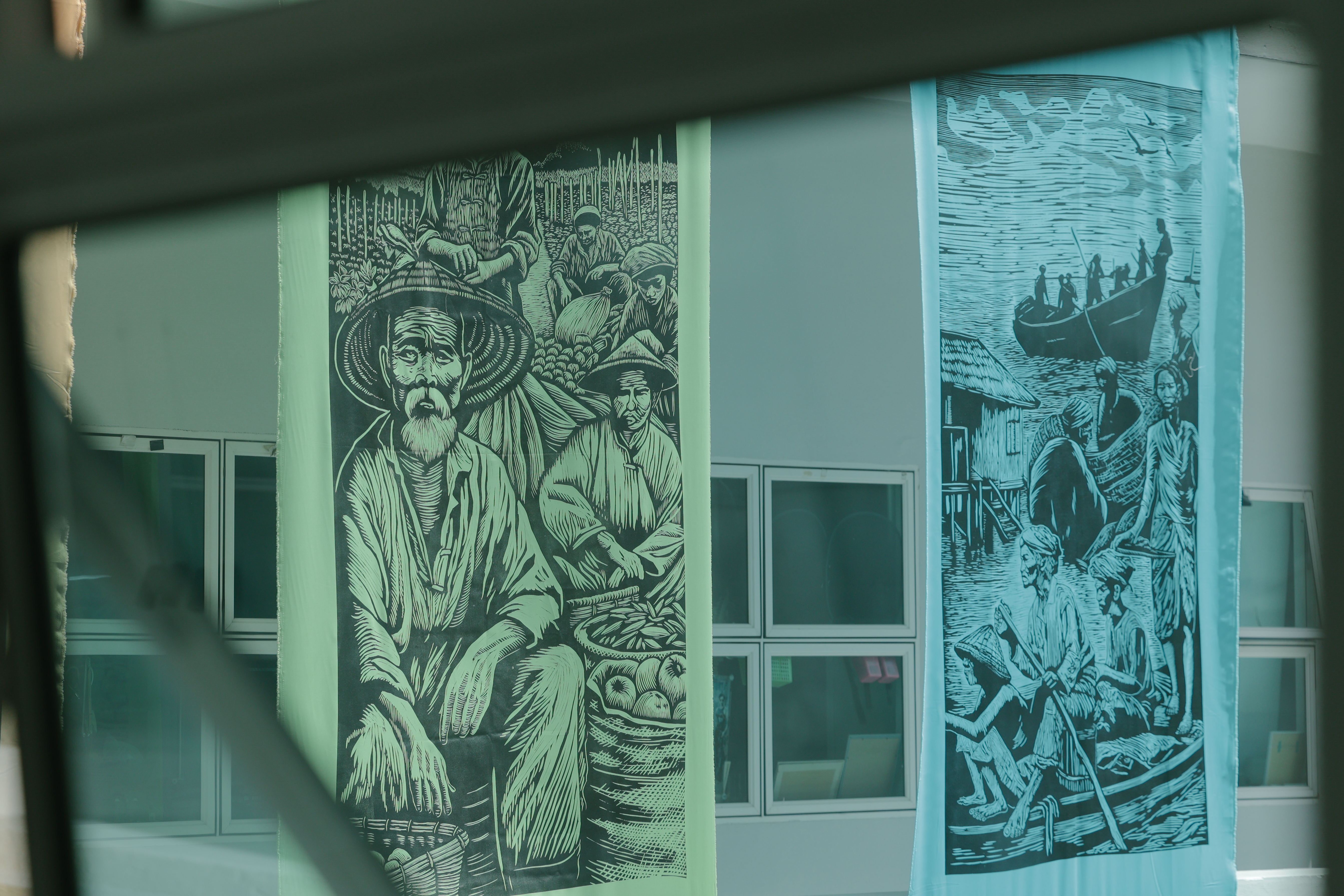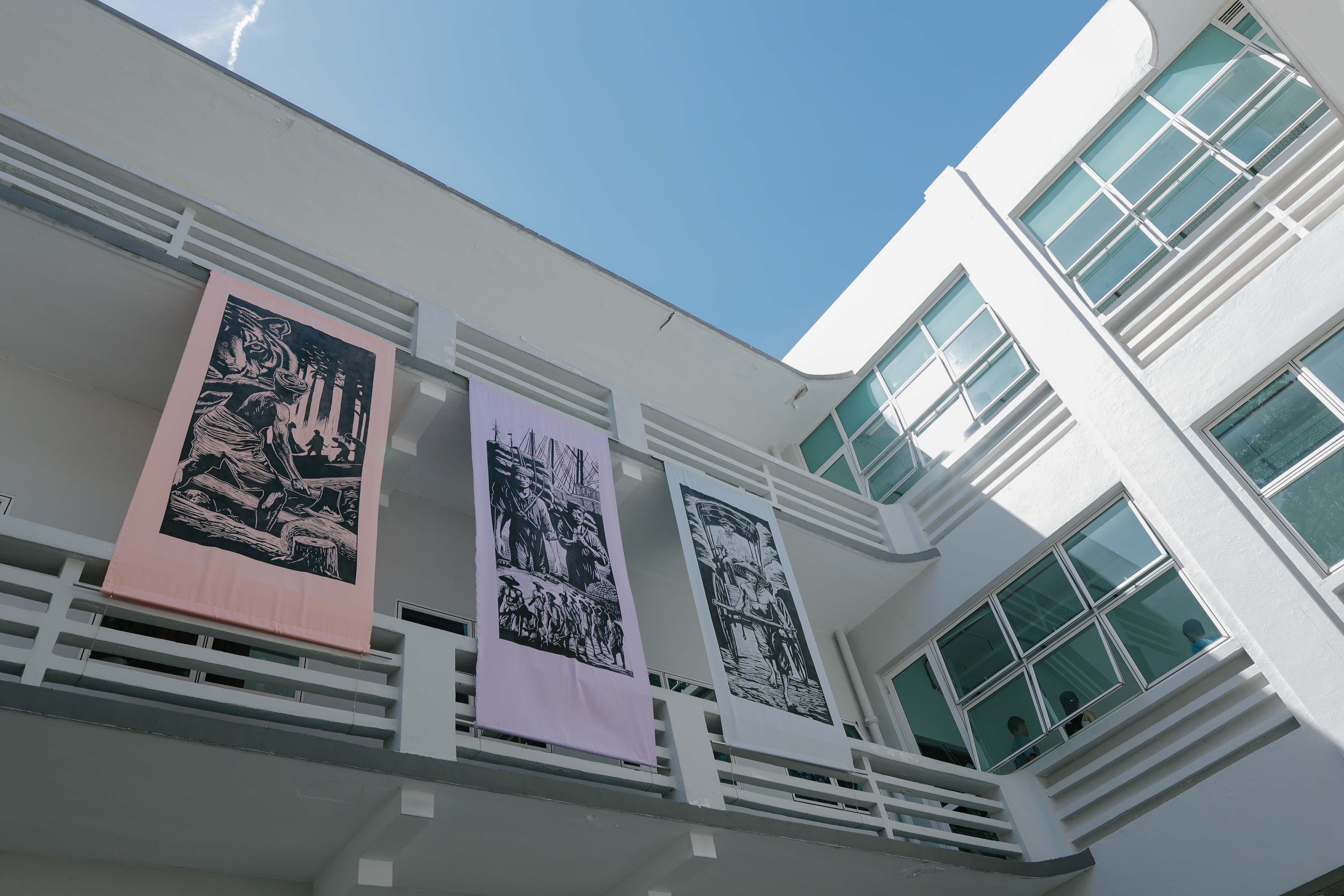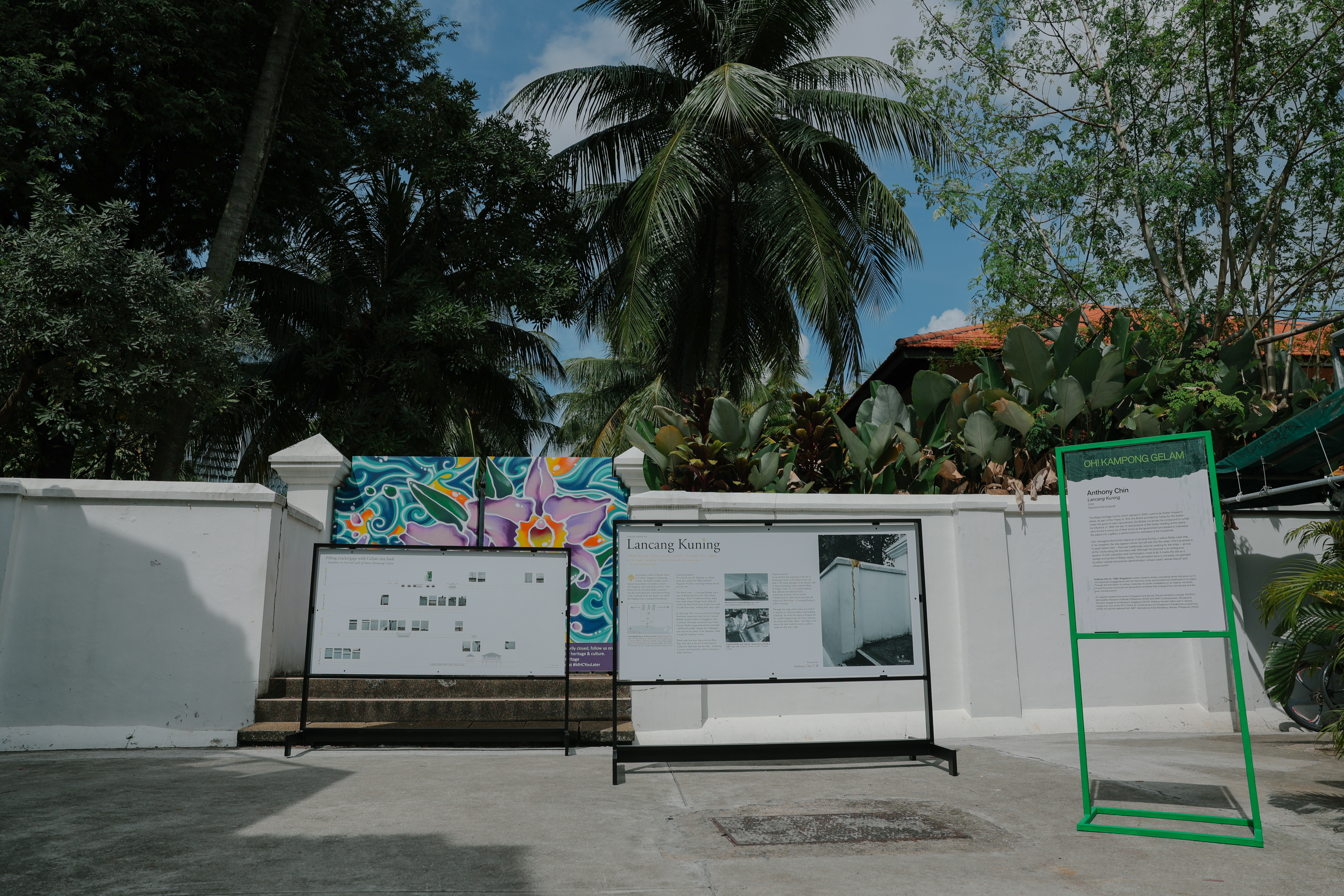OH! Kampong Gelam: Palimpsest (2024)
Kampong Gelam, Art WalkIn 1824, two roads halve the Sultan’s compound.
In 1966, the precinct is emptied out.
In 2023, the boundaries are redrawn once again.
Through 12 site-specific art installations that unearth stories within this neighbourhood, we explore how maps have constantly rewritten the story of Kampong Gelam.
Lines and boundaries, scraped and scratched into the surface over and over, until they blend into a palimpsest of fickle lines and faithless memories. For each road drawn, each building gazetted, each heritage plaque erected, there is a missing story that speaks of fractured spaces and displaced communities. This neighbourhood still holds its scars, scrapes and scratches, its dreams and tragedies.





Studio Loteng, 2024
Aliwal Arts CentreIn 1949, a very young Latiff Mohidin arrived at Kampong Gelam from Negeri Sembilan, Malaysia, setting foot in his father’s lodging house on 15 Java Road. Enrolling at the nearby Kota Raja Malay School, Latiff would eventually hold his inaugural solo exhibition in 1951 at the same school, aged just 10, before going on to carve out a prolific career as an artist and a poet which continues to this day.
This showcase is a window to imagine Kampong Gelam through the eyes of a young Latiff Mohidin, whose time growing up here coincided with the burgeoning of the Singapore art world in the post-war years. Through selected archival materials, Latiff’s visual and textual mapping provides inroads to little-known aspects of the Singapore art story.
If we should recognise that we come to Kampong Gelam fundamentally as outsiders, then here at least is a moment in time from within.
***
Latiff Mohidin (b. 1941, Malaysia) is a painter and poet living and working in Penang Island, Malaysia. He grew up in Kampong Gelam, Singapore between 1949 and 1954, where his passion for painting was discovered and he came to be known as “the magical boy with the gift in his hands.”
In 1960, Latiff Mohidin was awarded the Deutscher Akademischer Austauschdienst (DAAD) scholarship to pursue his studies at the Hochschule für bildende Künste in West Berlin, Germany. Since then, he has presented his work in exhibitions worldwide, most recently at Centre Pompidou (2018) and National Gallery Singapore (2020). He has also published literary collections, including GARIS Latiff Mohidin dari titik ke titik (1988) and a Malay translation of Goethe’s Faust (2012).
Syed Muhammad Hafiz (b. 1985, Singapore) is an independent curator whose work explores Singapore’s art history, particularly in relation to the visual cultures of the Malay Archipelago. Previously he was a Curator at Malay Heritage Centre (MHC) from 2022-24 and Assistant Curator at National Gallery Singapore (NGS) from 2012-18.
At MHC, he co-curated Cerita (2022), the gallery’s last exhibition before undergoing a major revamp. At NGS, he co-curated the landmark exhibitions Between Declarations & Dreams: Art of Southeast Asia Since the 19th Century and Between Worlds: Raden Saleh & Juan Luna. Since then, he has curated for several galleries in Singapore and Malaysia, as well as written for private collections in the region. He was the Associate Curator for OH! Open House programme, For the House; Against the House: Judging Labels: Are they useful? (2020) and OH!'s inaugural Associate Artist Programme.
This showcase is a window to imagine Kampong Gelam through the eyes of a young Latiff Mohidin, whose time growing up here coincided with the burgeoning of the Singapore art world in the post-war years. Through selected archival materials, Latiff’s visual and textual mapping provides inroads to little-known aspects of the Singapore art story.
If we should recognise that we come to Kampong Gelam fundamentally as outsiders, then here at least is a moment in time from within.
***
Latiff Mohidin (b. 1941, Malaysia) is a painter and poet living and working in Penang Island, Malaysia. He grew up in Kampong Gelam, Singapore between 1949 and 1954, where his passion for painting was discovered and he came to be known as “the magical boy with the gift in his hands.”
In 1960, Latiff Mohidin was awarded the Deutscher Akademischer Austauschdienst (DAAD) scholarship to pursue his studies at the Hochschule für bildende Künste in West Berlin, Germany. Since then, he has presented his work in exhibitions worldwide, most recently at Centre Pompidou (2018) and National Gallery Singapore (2020). He has also published literary collections, including GARIS Latiff Mohidin dari titik ke titik (1988) and a Malay translation of Goethe’s Faust (2012).
Syed Muhammad Hafiz (b. 1985, Singapore) is an independent curator whose work explores Singapore’s art history, particularly in relation to the visual cultures of the Malay Archipelago. Previously he was a Curator at Malay Heritage Centre (MHC) from 2022-24 and Assistant Curator at National Gallery Singapore (NGS) from 2012-18.
At MHC, he co-curated Cerita (2022), the gallery’s last exhibition before undergoing a major revamp. At NGS, he co-curated the landmark exhibitions Between Declarations & Dreams: Art of Southeast Asia Since the 19th Century and Between Worlds: Raden Saleh & Juan Luna. Since then, he has curated for several galleries in Singapore and Malaysia, as well as written for private collections in the region. He was the Associate Curator for OH! Open House programme, For the House; Against the House: Judging Labels: Are they useful? (2020) and OH!'s inaugural Associate Artist Programme.
Artist:
Latiff Mohidin (with Syed Muhd Hafiz)
Archival reproductions and works from the Mary Ann and Jimmy Chua collection
Dimensions variable
Latiff Mohidin (with Syed Muhd Hafiz)
Archival reproductions and works from the Mary Ann and Jimmy Chua collection
Dimensions variable






Geometria Situ: Traces and the Poetics of Translation, 2024
Hothouse (Aliwal Arts Centre)We experience and remember spaces differently. What would a space look like if our collective memories were gathered and made visible for one another to witness?
In this interactive video game installation, Hothouse transformed their studio into a hybrid Memory Palace-Theatre. As audiences wander through a virtual scan of the space, they encounter and activate the memories and impressions of four artist-traceurs: Kerem Ozan Bayraktar, Rafi Abdullah, Ruby Jayaseelan, and Safuan Johari. Each of them responds in unique ways to the locale of Hothouse and Kampong Gelam, from Kerem’s subterranean exploration of drainage pipes to Rafi’s speaking birds, from Ruby’s animate trees and spirits to Safuan’s sonic reimaginations of Teater Ekamatra’s rehearsals.
Tracing different memories and offering speculative perspectives, the artwork invites us to consider the other lives of Kampong Gelam beyond what is seen.
***Geometria Situ: Traces and the Poetics of Translation is an Internal Practice (IP) conceptualised, curated and developed by Singapore-based Hothouse—a symbiosis of three entities—creative design agency Currency, speculative architecture research lab formAxioms (fXØ) and new media art collective INTER–MISSION. It was first presented as part of Singapore Art Week 2024, with support from Teater Ekamatra and the National Arts Council.
Hothouse (est. 2020, Singapore) is a site for exchange between artists, creatives, businesses, and local and international audiences. External to institutional frameworks, the humid ecologies of the greenhouse foster productive encounters for the deployment and reinforcement of critical and long-form creative practices. Hothouse does not shy away from speculation, excess, ambivalence, redundancy, ambiguity, inefficiency, etc. Today, it maintains a technological transdisciplinary focus with an international and intergenerational perspective through its signature programme of residencies, events, and publications.
In this interactive video game installation, Hothouse transformed their studio into a hybrid Memory Palace-Theatre. As audiences wander through a virtual scan of the space, they encounter and activate the memories and impressions of four artist-traceurs: Kerem Ozan Bayraktar, Rafi Abdullah, Ruby Jayaseelan, and Safuan Johari. Each of them responds in unique ways to the locale of Hothouse and Kampong Gelam, from Kerem’s subterranean exploration of drainage pipes to Rafi’s speaking birds, from Ruby’s animate trees and spirits to Safuan’s sonic reimaginations of Teater Ekamatra’s rehearsals.
Tracing different memories and offering speculative perspectives, the artwork invites us to consider the other lives of Kampong Gelam beyond what is seen.
***Geometria Situ: Traces and the Poetics of Translation is an Internal Practice (IP) conceptualised, curated and developed by Singapore-based Hothouse—a symbiosis of three entities—creative design agency Currency, speculative architecture research lab formAxioms (fXØ) and new media art collective INTER–MISSION. It was first presented as part of Singapore Art Week 2024, with support from Teater Ekamatra and the National Arts Council.
Hothouse (est. 2020, Singapore) is a site for exchange between artists, creatives, businesses, and local and international audiences. External to institutional frameworks, the humid ecologies of the greenhouse foster productive encounters for the deployment and reinforcement of critical and long-form creative practices. Hothouse does not shy away from speculation, excess, ambivalence, redundancy, ambiguity, inefficiency, etc. Today, it maintains a technological transdisciplinary focus with an international and intergenerational perspective through its signature programme of residencies, events, and publications.
Artist:
Hothouse (with Kerem Ozan Bayraktar, Rafi Abdullah, Ruby Jayaseelan, Safuan Johari)
Interactive video game installation
Dimensions variable
Hothouse (with Kerem Ozan Bayraktar, Rafi Abdullah, Ruby Jayaseelan, Safuan Johari)
Interactive video game installation
Dimensions variable



People of the Land, 2024
Aliwal Arts Centre“The History of the world is but the Biography of great men.” — Thomas Carlyle
In a former colonial state littered with tributes to Sir Stamford Raffles, Pangrok Sulap offers the opposite side of the coin: the history of the world is also written by ordinary people.
Referencing the 1871 Census, the first systematic census of Singapore, People of the Land is a series of drawings of the ordinary people who lived and toiled in Singapore, including fishermen, labourers, and carpenters. Of note, the census enumerates great ethnic diversity. Subsequent censuses would collapse it into the familiar idiom of Chinese, Malay, Indian, Others.
The title of the work underscores the profound yet understated role of ordinary human beings in shaping history. The Sabahan collective, known for giving voice to marginalised communities, believes that history is incomplete without recognising the people on the ground.
***
Pangrok Sulap (est. 2010, Malaysia) is a multidisciplinary art collective. Established in Sabah, Malaysia, the collective is made up of artists, curators, writers, researchers, activists, musicians, designers, craftspeople and many others. As part of its mission to strengthen communities through art, the collective has organised art exhibitions, projects, and collaborations with communities to support their social, cultural, economic and educational development.
Pangrok Sulap has participated in various art exhibitions worldwide. Notable exhibitions include Falls of the Evolution, Aichi Triennale (2019); and Escape from the SEA, Japan Foundation Kuala Lumpur (2017). Pangrok Sulap was part of OH! Open House’s inaugural Associate Artist Programme 2022/23 cycle (September 2022 to October 2023).
In a former colonial state littered with tributes to Sir Stamford Raffles, Pangrok Sulap offers the opposite side of the coin: the history of the world is also written by ordinary people.
Referencing the 1871 Census, the first systematic census of Singapore, People of the Land is a series of drawings of the ordinary people who lived and toiled in Singapore, including fishermen, labourers, and carpenters. Of note, the census enumerates great ethnic diversity. Subsequent censuses would collapse it into the familiar idiom of Chinese, Malay, Indian, Others.
The title of the work underscores the profound yet understated role of ordinary human beings in shaping history. The Sabahan collective, known for giving voice to marginalised communities, believes that history is incomplete without recognising the people on the ground.
***
Pangrok Sulap (est. 2010, Malaysia) is a multidisciplinary art collective. Established in Sabah, Malaysia, the collective is made up of artists, curators, writers, researchers, activists, musicians, designers, craftspeople and many others. As part of its mission to strengthen communities through art, the collective has organised art exhibitions, projects, and collaborations with communities to support their social, cultural, economic and educational development.
Pangrok Sulap has participated in various art exhibitions worldwide. Notable exhibitions include Falls of the Evolution, Aichi Triennale (2019); and Escape from the SEA, Japan Foundation Kuala Lumpur (2017). Pangrok Sulap was part of OH! Open House’s inaugural Associate Artist Programme 2022/23 cycle (September 2022 to October 2023).
Artist:
Pangrok Sulap
Woodcut prints on blackout cotton
335 x 152 cm each
Pangrok Sulap
Woodcut prints on blackout cotton
335 x 152 cm each




Lancang Kuning, 2024
Outside Malay Heritage CentreThe Malay Heritage Centre, which opened in 2005, used to be Sultan Hussein’s Istana. As part of the Treaty of 1819, the British provided an Istana for the Sultan. Under the guise of road improvement, the British cut across his compound to curtail his influence. In 1999, the last 14 descendants of the Sultan residing at the Istana were forced to move out of their home as the government proceeded to redevelop the palace into a gallery, a painful event for members of the household.
Chin reimagines the former Istana as a Lancang Kuning, a yellow Malay royal ship. In his metaphor, the ship appears whole, but will sink into the water. Chin’s proposal is to apply Gelam bark — that was traditionally used as caulking for the ships — across all the cracks along the boundary wall. Although his proposal is an ambiguous gesture of both restoration and recrimination, most of all, it marks the site as a vestige and symbol of Malay royalty. This persistent issue is not easily recuperated by either colonial and postwar administration: whose roads? whose Istana? and whose lands?
***
Anthony Chin (b. 1969, Singapore) creates research-driven, conceptual works that grow out of site-responsive engagements with the historical, social, and architectural stratifications of a place. Through the articulation of ordinary materials into poetic installations or art objects, his works unravel the power structures and geopolitical narratives that undergird the colonial past and the post-colonial present.
He regularly presents his works in Singapore and abroad. Recent exhibitions include TROPHY, Metropolitan Museum of Manila, Philippines (2020) and SAM Contemporaries: Residues & Remixes, Singapore Art Museum, Singapore (2023). Anthony has also taken part in various residencies such as the NTU Centre for Contemporary Art Singapore’s Residencies programme (2023-24) and the National NAC-MET International Artist Residency, Manila, Philippines (2020).
Chin reimagines the former Istana as a Lancang Kuning, a yellow Malay royal ship. In his metaphor, the ship appears whole, but will sink into the water. Chin’s proposal is to apply Gelam bark — that was traditionally used as caulking for the ships — across all the cracks along the boundary wall. Although his proposal is an ambiguous gesture of both restoration and recrimination, most of all, it marks the site as a vestige and symbol of Malay royalty. This persistent issue is not easily recuperated by either colonial and postwar administration: whose roads? whose Istana? and whose lands?
***
Anthony Chin (b. 1969, Singapore) creates research-driven, conceptual works that grow out of site-responsive engagements with the historical, social, and architectural stratifications of a place. Through the articulation of ordinary materials into poetic installations or art objects, his works unravel the power structures and geopolitical narratives that undergird the colonial past and the post-colonial present.
He regularly presents his works in Singapore and abroad. Recent exhibitions include TROPHY, Metropolitan Museum of Manila, Philippines (2020) and SAM Contemporaries: Residues & Remixes, Singapore Art Museum, Singapore (2023). Anthony has also taken part in various residencies such as the NTU Centre for Contemporary Art Singapore’s Residencies programme (2023-24) and the National NAC-MET International Artist Residency, Manila, Philippines (2020).
Artist:
Anthony Chin
Rejected artist proposal
Anthony Chin
Rejected artist proposal
